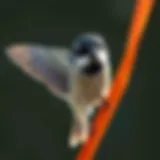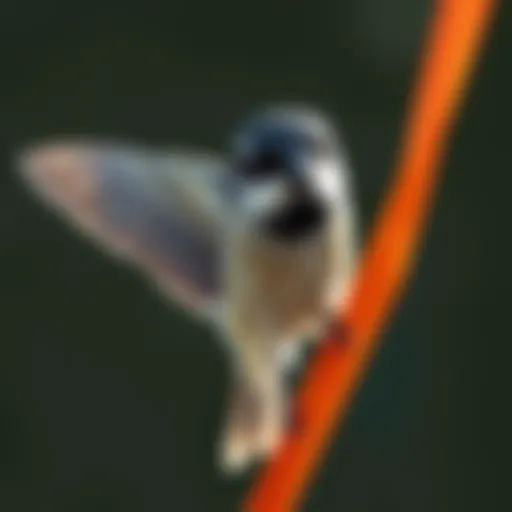Effective Strategies for Treating Ants with Borax
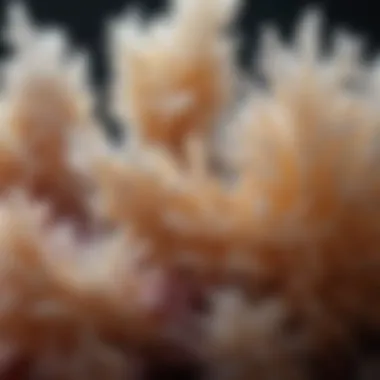

Intro
Managing ant infestations can be challenging for homeowners. Understanding the pests and utilizing effective strategies is crucial. This article focuses on using borax for ant control. Borax disrupts ant behavior and serves as an environmentally friendly alternative to harsh chemicals. In the following sections, we will outline essential information about pests, prevention techniques, and eco-friendly solutions.
Understanding Pests
Definition of Pests
Pests are organisms that pose a threat to human health, property, and agriculture. They can include insects, rodents, and other unwanted creatures. Ants fall into this category due to their ability to invade homes and contaminate food. A few common ant species include the black garden ant, carpenter ant, and pavement ant.
Importance of Pest Identification
Identifying the specific type of ant is vital in determining the best treatment method. Different species may require unique approaches for effective control. For instance, carpenter ants damage wood structures, while sugar ants are primarily attracted to sweet substances. Understanding ant behavior aids in deploying targeted strategies.
Prevention Techniques
Home and Garden Preventative Measures
Before encountering an infestation, proactive measures can minimize the risk. Consider the following steps:
- Seal entry points: Inspect windows, doors, and cracks in the foundation.
- Store food securely: Keep food in airtight containers to deter ants.
- Maintain cleanliness: Regularly clean surfaces, especially those with food residues.
- Manage landscaping: Trim plants away from walkways to prevent ants from accessing the structure.
Seasonal Prevention Tips
Ant behavior changes with the seasons. During warmer months, they become more active. In spring, ants search for food and nesting sites. Preparing your home in advance can lessen the likelihood of infestations. Here are seasonal actions:
- Spring: Inspect and seal potential entry points around the house.
- Summer: Keep food items stored properly and reduce clutter.
- Autumn: Remove fallen fruits and foliage from the yard to eliminate food sources.
- Winter: Ensure that any potential warmth sources near the exterior are sealed.
Eco-Friendly Pest Control Solutions
Overview of Sustainable Practices
Eco-friendly pest control focuses on non-toxic solutions. Using natural products is increasingly appealing to those concerned about health and ecological impact. Borax is one such solution known for its effectiveness against ants. Its low toxicity levels make it suitable for households with children and pets.
Natural Remedies and Their Effectiveness
In addition to borax, various natural remedies exist. Examples include:
- Vinegar: Acts as a repellent due to its strong odor.
- Essential oils: Oils like peppermint and tea tree are deterrents for ants.
Each method's effectiveness may vary depending on the ant species and the severity of the infestation. Employing several strategies together often yields the best results.
"A comprehensive approach to pest control combines understanding pests, preventive measures, and eco-friendly solutions."
These insights will help homeowners and DIY enthusiasts manage ant infestations more effectively, showing that treating pests responsibly is possible.
Intro to Ant Infestations
Ant infestations can be a significant concern for homeowners. Ants are not just nuisances; they can damage property, contaminate food, and even affect the health of residents. Understanding why ants invade homes is crucial. They search for food, shelter, and water, and often find these necessities in our living spaces. This article will focus on the behaviors of ants, the species commonly found in urban environments, and how borax can be effectively used to manage these infestations.
Understanding Ant Behavior
Ants exhibit complex behaviors that influence their infestations. They communicate through pheromones, which guide their colonies to food sources and establish paths for others to follow. This collective behavior ensures efficiency in foraging and resource management. Knowing how this communication works is important in designing effective pest control strategies.
In a colony, the queen is central to reproduction, while worker ants maintain the nest and forage for food. This hierarchy means that when ants are treated with toxic substances, the entire colony may not be eliminated if the bait does not reach the queen and her brood. Hence, treating ants with borax requires understanding when and how to apply it effectively.
Common Ant Species in Urban Areas
Various ant species inhabit urban areas, each with distinct behaviors and preferences. Some of the most common include:
- Carpenter Ants: These ants prefer damp wood and can cause structural damage.
- Argentine Ants: Known for forming supercolonies, they are aggressive foragers.
- Odorous House Ants: Recognizable by their smell, these ants are often found near food sources.
- Pavement Ants: They build nests in cracks and crevices of pavements.
Recognizing these species is essential when using borax, as different species might respond uniquely to treatments. Understanding their nesting habits and food preferences can guide the selection of bait formulations that will attract them effectively.
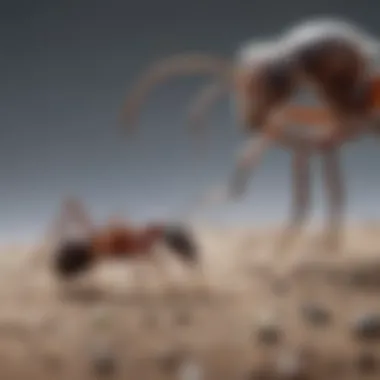

"Ant behavior is critical in pest management; improper treatment can lead to reinfestation and persistent problems."
What is Borax?
Understanding what borax is, is crucial when considering effective strategies for treating ants. Borax, known chemically as sodium borate, is a naturally occurring mineral which is commonly used in various household products. Its importance lies not only in its general usage, but in its specific application for pest control. Households dealing with ants often seek solutions that are both effective and environmentally friendly, making borax an appealing option.
Chemical Composition of Borax
Borax is primarily composed of sodium, boron, oxygen, and water. Its chemical formula is Na₂B₄O₇·10H₂O. This composition makes borax a versatile compound with a variety of properties. In its crystalline form, it appears as clear, white or slightly opaque granules. The presence of boron is particularly significant, as it plays a key role in disrupting the physiological processes of ants, affecting their ability to survive and function.
The unique chemistry of borax is what enables it to be an effective insecticide. When ingested by ants, it interferes with their metabolism and hydration levels. This makes borax not just a deterrent, but a lethal agent that targets ant colonies directly.
Historical Uses of Borax
Borax has a long history of use that extends far beyond pest control. Historically, it has been used in cleaning products, glass production, and even as a food preservative. Its antibacterial properties made it valuable in various domestic applications. In traditional medicine, it was utilized for its antiseptic qualities.
In the context of pest control, borax has been recognized for decades. It gained popularity in the mid-20th century as an alternative to synthetic pesticides. This shift towards using borax reflects a growing awareness of environmental concerns and the desire for safer, non-toxic solutions. It's not just an insecticide; it's a long-standing ally in creating a cleaner, safer home environment.
Key Takeaway: Borax's chemical composition and historical versatility underscore its effectiveness and safety as a pest control agent, especially for ant management.
Mechanism of Action
Understanding how borax functions to control ant populations is crucial for effective pest management. The mechanism of action goes beyond basic application; it involves the interplay between borax's chemical composition and ant behavior. This knowledge can enhance the efficacy of treatment and inform choices homeowners make when dealing with ant infestations.
How Borax Affects Ant Physiology
Borax, or sodium borate, is a naturally occurring mineral that has a significant impact on ant physiology. When ingested, borax disrupts the digestive systems of ants, leading to dehydration and eventual death. The sweet taste also lures ants, making them more inclined to consume it. This method of action can be particularly effective as it targets the colony’s core. As worker ants consume the bait, they transport it back to their nests, effectively disseminating the toxin among their peers.
Moreover, the slow-acting nature of borax allows time for more ants to consume it before any immediate effects are seen. This delayed action increases the likelihood that the poison will spread throughout the colony, assassinating more ants than just those who initially consume it.
Disruption of Ant Communication
Ants operate based on a sophisticated communication system primarily reliant on pheromones. These chemical signals guide their behavior and social interactions, influencing tasks such as foraging, nest maintenance, and defense. Borax disrupts this communication by affecting the ants' ability to produce or respond to pheromones. Consequently, the entire structure of the colony can begin to falter.
When ants ingest borax, the poisoning can lead to disorientation and confusion. As a result, foragers may not return to the nest, and tasks that depend on coordination can suffer. The breakdown in communication ultimately impairs the colony’s functionality, promoting disarray that can facilitate further control measures.
"Utilizing borax effectively hinges on an understanding of the precise mechanisms at work against these social insects."
Understanding these two key elements—physiological impact and communication disruption—allows for a more strategic approach in dealing with ant populations. Homeowners can tailor their borax application strategies based on these insights, ensuring a more informed and impactful pest control effort.
Preparing Borax Solutions
In managing ant infestations, preparing borax solutions is a critical step. It determines how effective the treatment will be against various ant species. Borax, or sodium borate, works through its toxicity to ants when ingested. Thus, creating a bait that attracts ants to consume the borax is essential. The formulation of this solution can significantly influence the success of your pest control efforts.
Ingredients for Effective Baits
Selecting the right ingredients for your borax bait is key. Ants are often attracted to sugary substances, so their natural preferences must be considered. Combinations of borax with sugar or other sweeteners create a powerful lure. Commonly used ingredients include:
- Granulated Sugar: Simple and effective, as it attracts a broad range of ant species.
- Peanut Butter: Adds protein, which can be appealing to ants like carpenter ants.
- Corn Syrup: Provides a sticky texture that ensures ants will remain with the bait longer.
- Water: While not a bait itself, mixing borax into a water solution can enhance the slow release and absorption.
Using these ingredients, the bait can become more enticing. This, in turn, ensures a higher likelihood of attracting the ants and getting them to consume the borax.
Mixing Ratios and Techniques
Getting the correct mixing ratios and techniques is essential for preparation. Diluting borax properly can maximize its effectiveness while ensuring safety. A common mixing guideline is:
- Borax to Sugar Ratio: Mixing one part borax with three parts sugar often achieves a balanced bait that ants find appealing.
- Solution for Liquid Baits: For a liquid bait, a ratio of 1 cup of water to 2 tablespoons of borax and 1 cup of sugar works well. Stir thoroughly until fully dissolved.
When preparing the bait, it is important to take steps to ensure consistency. Here are some techniques to consider:
- Dissolving: Always dissolve borax completely in the solution. Any undissolved particles may deter ants from approaching the bait.
- Test Batch: Before mass production, prepare a small test batch to assess how the ants respond. Adjust ingredients based on ant preference in your area.
"Effective bait preparation is critical to achieving a successful ant management strategy."
By focusing on these preparation details, homeowners can enhance their pest control strategies using borax. This not only makes treatments more effective but also aligns with environmentally conscious practices.
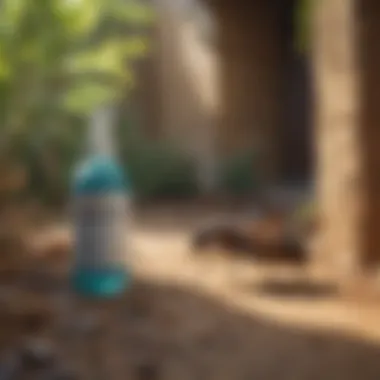

Application Methods
The application methods for borax in ant management are critical to the overall effectiveness of the treatment. Knowing how to apply borax properly can make a significant difference in the success of pest control efforts. Effective strategies help ensure that the borax bait reaches the target ants, maximizes the substance's lethal potential, and reduces risks to children and pets in the home or yard. Misapplication can lead to wasted resources and ineffective pest control, as ants might avoid baits that are not appealing or are improperly placed. In this section, we will explore two primary approaches: indoor application techniques and outdoor application strategies.
Indoor Application Techniques
Indoor application of borax requires a thoughtful approach. Homeowners should focus on high-traffic areas where ants are frequently seen. The bait can be effectively used in conjunction with commonly found foods that attract ants. For example, mixing borax with sugar creates a highly enticing bait that draws ants in. When using borax indoors, consider the following steps:
- Identify Trails: Observe and follow ant trails to understand where the colonies source food.
- Prepare Bait Mixture: Combine three parts sugar with one part borax. This combination attracts ants while providing them with the necessary ingredient for elimination.
- Distribute Bait: Place small amounts of the bait mixture in shallow dishware or on small pieces of cardboard. Common locations for placements include kitchen counters, pantries, and under sinks.
- Monitor the Effectiveness: Remove any unused bait after a few days to avoid attracting non-target pests.
Indoor application should always consider the safety of household members. Place bait in areas that are inaccessible to pets and children. This proactive measure reduces risks while still capitalizing on the effectiveness of borax.
Outdoor Application Strategies
When it comes to outdoor application, the methods differ slightly due to environmental factors. Ants often forage outside, looking for food to carry back to their colonies. Therefore, bait placement becomes crucial. To effectively use borax outdoors, one should consider the following recommendations:
- Target Ant Paths: Identify frequent paths outside, often evident from visible trails. This is where bait should be placed.
- Choose Suitable Locations: Place bait stations close to nesting areas. Under potted plants, at the base of trees, or along garden edges are good options.
- Bait Formulation for the Outdoors: A mix of borax and honey or syrup can be used. Many ants have a strong affinity for sweet substances. Mix one part borax with three parts honey to create a potent outdoor bait.
- Regularly Refresh Bait: Weather can degrade bait effectiveness. Reapply emerging formulas every few days, especially after rain or heavy winds.
Taking care to monitor outdoor treatments is crucial. Not only do you want to gauge the effectiveness, but you also want to prevent unwanted visitors, such as squirrels or birds, from consuming the bait.
Effective application methods for borax can make a significant difference when dealing with ant infestations, whether indoors or out.
Understanding and implementing proper application methods is fundamental. By focusing on specific techniques for both indoor and outdoor environments, homeowners can significantly increase the likelihood of successful ant control with borax.
Safety Precautions
Safety must be a paramount consideration when using borax for pest control. While borax is recognized for its efficacy in treating ant infestations, it is also crucial to understand the potential hazards associated with its use. Proper handling and application can prevent unintended harm to both humans and pets, as well as mitigate any adverse environmental impacts.
Handling Borax Safely
When working with borax, it is vital to adopt safe handling practices. Firstly, always store borax in a container that is clearly labeled. Keep it out of reach of children and pets. Wearing gloves is advisable to avoid skin irritation, especially if you are mixing solutions or preparing bait. If any borax powder gets on your skin, wash it off with soap and water immediately.
Follow the manufacturer's guidelines regarding the amount you should use. It is easy to over-apply borax out of eagerness, but this can lead to unnecessary risks and environmental consequences. Make sure to use it in areas where it is most needed, minimizing exposure in high-traffic zones of your home. Should any borax accidentally spill, clean it up promptly to prevent slip hazards.
In case of ingestion or if it comes into contact with the eyes, seek medical attention right away. Understanding the toxicity levels associated with borax is critical. While it is considerably less toxic than many commercial pesticides, attention to safety is still necessary for proper usage.
Environmental Considerations
Another key aspect of using borax is its impact on the environment. Borax is naturally occurring and, when used properly, it is less harmful to the ecosystem compared to synthetic chemicals. However, excessive use can lead to accumulation in the soil and waterways, potentially affecting non-target species.
An important point is that borax can affect beneficial insects, including bees and butterflies, when misapplied. Therefore, applying borax strategically in targeted areas is recommended. Additionally, avoid using it near flowering plants where these beneficial insects may forage.
Ultimately, while borax is an eco-friendlier option compared to traditional pesticides, responsible usage cannot be overstated. Monitoring the effectiveness of your treatments and adjusting practices as necessary will help to minimize any negative environmental impacts. Always consider alternative pest control methods that are equally safe and effective. This approach ensures that pest management does not come at the cost of harming your surrounding ecosystem.
"Using borax responsibly allows you to manage pests efficiently while maintaining a commitment to environmental stewardship."
Employing these safety measures enhances your effectiveness in dealing with ant infestations while ensuring the well-being of your family and the environment.
Effectiveness of Borax Against Different Ant Species
Borax is a well-known substance in pest control, particularly for managing ant infestations. Understanding its effectiveness against various ant species is crucial for effective ant management. The article will highlight key points regarding borax's action, benefits, and important considerations when deploying this method.
The effectiveness of borax can vary significantly based on the type of ant species being targeted. Diverse ant species have different behaviors, diets, and weaknesses. This variability necessitates a tailored approach when using borax to ensure successful eradication. By knowing which specific species you are dealing with, you can effectively select the right strategies and formulations.
In addition to various species, the benefits of utilizing borax should not be overlooked. When properly formulated and applied, borax can disrupt the ant colonies at their core. This leads to decreased populations in your home. Moreover, while using borax, homeowners can engage in an environmentally friendly option, minimizing harm to other local fauna and flora.
Not everything is straightforward, and using borax effectively requires knowing the challenges associated with its use against certain ant species. Some might develop resistance over time, making borax less effective. Additionally, variations in feeding preferences or nesting habits can impact how well borax works in specific scenarios. Understanding these limitations helps homeowners manage expectations and devise alternative strategies if required.
"Successfully treating ants with borax hinges on a thorough understanding of the species involved and how they interact with the bait configurations."
Comparative Efficacy by Species
Different ant species show varying degrees of susceptibility to borax. For example, Carpenter ants may respond differently than Odorous house ants. Carpenter ants tend to nest inside wood, making it challenging for any bait to reach the queen. On the other hand, odorous house ants frequently forage for sugary substances and are more attracted to borax baits that incorporate sugar. Effective bait formulations need to be adjusted based on these behavioral nuances.


Household ant populations are often dominated by Pavement ants and Pharaoh ants. Pavement ants are known for their aggressive foraging habits, while pharaoh ants are small and can quickly spread throughout a home. Borax can be quite effective against both, assuming the bait is strategically placed where the ants are most active.
Here are some key points to consider regarding efficacy by species:
- Carpenter ants: Less effective due to nesting habits.
- Odorous house ants: High efficacy, attracted to sweet baits.
- Pavement ants: Effective; needs to be placed strategically.
- Pharaoh ants: Requires careful placement to maximize exposure.
Case Studies of Borax Use
Several case studies reflect the real-world application of borax in managing different species of ants. One notable case involved a household grappling with a persistent odorous house ant infestation. The homeowner utilized a borax-sugar bait mix, deploying it around known entry points and areas of heavy foraging activity. Over the course of a few weeks, marked reductions in ant traffic were observed until the presence of ants diminished significantly.
In another incident, a business faced a severe carpenter ant problem. Borax was integrated into a broader pest management plan, including physical removal of nesting sites. Although borax didn’t provide instant results, the combined strategy eventually eradicated the ants.
To summarize, leveraging borax against different ant species necessitates an understanding of each species' unique characteristics and behaviors. While the effectiveness can vary widely, strategic formulations and placements tailored to specific species markedly enhance the outcomes of borax use.
Limitations and Challenges
Understanding the limitations and challenges associated with using borax in ant control is crucial for effective management. This section explores the factors that can hinder the success of borax treatments and outlines situations in which relying solely on borax may not suffice. Recognizing these aspects allows homeowners to develop a more comprehensive pest management strategy.
Resistance Development in Ant Populations
Over time, ant populations may develop resistance to various control methods, including borax. This phenomenon occurs when a subset of ants survives exposure to a particular treatment and passes on the resistance trait to future generations. The stress of frequent exposure to borax may lead some ants to adapt, making them less susceptible to its effects. As a result, treatment with borax may become less effective or even ineffective over time.
To combat resistance, it is vital to integrate multiple pest control methods. Rotating different insecticides and using borax selectively can greatly help mitigate resistance. By combining borax with other treatments, such as baiting systems or traps, homeowners may achieve better results and prolong the efficacy of the used solutions.
Situations Where Borax May Fail
While borax is a valuable tool in managing ant infestations, there are specific scenarios where it might not work effectively. Certain environmental conditions or ant species can limit its efficacy. For example, extreme weather conditions, such as heavy rain, can wash away borax solutions, rendering them ineffective. Similarly, if ants have access to alternative food sources, they may ignore borax baits, leading to poor infestation management.
Some ant species display behaviors that resist conventional control methods. Carpenter ants, for instance, may not readily consume bait that contains borax, preferring other food sources. Additionally, the presence of multiple colonies can complicate control efforts, as some ants may be more resilient to treatment.
Homeowners should be aware of these potential shortcomings. Investigating the particular ant species present and adapting strategies accordingly can enhance pest control efforts. Combining borax with preventative measures, such as sealing entry points or addressing moisture issues, is also essential to keep infestations at bay.
Integrating Borax with Other Pest Control Methods
In the pursuit of effective ant management, considering a multifaceted approach can yield superior results. This section emphasizes the significance of integrating borax with other pest control methods. Such integration enhances overall efficacy and addresses situations where borax may not fully resolve ant infestations on its own.
This article explores the complementary roles of various eco-friendly pest control strategies alongside borax. Not all ant problems are the same; therefore, it is critical to adapt methods that surround the specific conditions of an infestation. Employing different modes of control can facilitate achieving long-term results while also prioritizing safety and environmental health.
Complementary Eco-Friendly Solutions
When combining borax with other eco-friendly measures, eco-conscious homeowners can utilize different techniques to manage ant populations. Here are some of the effective strategies that can complement the action of borax:
- Essential Oils: Utilizing essential oils like peppermint or tea tree oil can act as repellents, disrupting ant trails while allowing borax to target the colony.
- Diatomaceous Earth: This natural powder can be spread around areas prone to ant activity. It does not harm beneficial insects and can cause abrasion to ants, acting synergistically with borax treatment.
- Vinegar Solutions: Mixing equal parts of vinegar and water and spraying it on ant trails can effectively remove pheromone signals that guide ants. Following this with borax application can amplify the pest control effect.
"Integrating borax with other eco-friendly solutions not only boosts control efficacy but often results in a calmer approach, respecting both human health and the environment."
Using these solutions in conjunction with borax not only aids in immediate ant control but also works towards prevention, minimizing the chance of future invasions.
Preventative Measures for Long-Term Control
To achieve lasting results in ant management, it is essential to combine borax treatments with preventative methods. While borax effectively targets existing colonies, proactive strategies can inhibit new infestations. Consider the following measures:
- Sealing Entry Points: Identifying and sealing cracks, gaps, and holes in walls and foundations can prevent ants from entering your home. Pay special attention to areas around windows and doors.
- Regular Cleaning: Maintaining a clean environment deters ants. Make sure food is stored in airtight containers and that counters, floors, and nooks are free of crumbs and spills.
- Moisture Control: Ants are attracted to moisture, so fixing leaks, ensuring proper drainage, and using dehumidifiers in damp areas can reduce their appeal.
By implementing these preventative measures along with borax treatments, homeowners can foster an environment that is less hospitable to ants. This holistic approach to pest management not only addresses current infestations but also mitigates the risk of future invasions.
Culmination and Recommendations
In addressing ant infestations, the Conclusion and Recommendations section serves a critical function. It consolidates the key insights gleaned from the previous sections, emphasizing the significant role that borax can play in effective pest control. Understanding the efficacy of borax not only hinges on its chemical properties but also on its proper application. This is crucial for homeowners seeking an effective and environmentally conscious solution.
Summarizing Key Points
To summarize, several essential points emerge from the discussion on using borax for ant management:
- Borax's Mechanism of Action: It targets the physiological processes of ants, leading to their eventual demise. It disrupts their communication, hampering colony cohesion.
- Effective Preparation of Borax Solutions: Proper mixing ratios and baiting strategies were outlined, ensuring maximum effectiveness.
- Application Methods: Strategies for both indoor and outdoor settings were detailed to assist homeowners in effectively treating infestations in various environments.
- Safety Considerations: Recognizing the need for safety, the guidelines around handling borax safely and its environmental impact help to allay potential concerns homeowners may have.
- Integration with Other Methods: Understanding how borax can complement other pest control strategies is essential for comprehensive management.
Final Thoughts on Using Borax
- Sustainability: This solution aligns with eco-friendly practices. Borax is less harmful than many commercial pesticides, posing fewer risks to humans and pets.
- Cost-Effectiveness: Borax is generally inexpensive and easily accessible, making it a practical option for those managing infestations without significant financial burden.
- Ongoing Monitoring: Effective ant control requires vigilant monitoring. Homeowners should remain proactive in assessing ant activity and adapting their strategies accordingly.
In the battle against ant infestations, borax provides a strong alternative for homeowners aiming for a balance between effectiveness and safety, while also offering an opportunity for sustainable living practices. Taking the time to learn and apply the strategies discussed can lead to successful management of these persistent pests.
